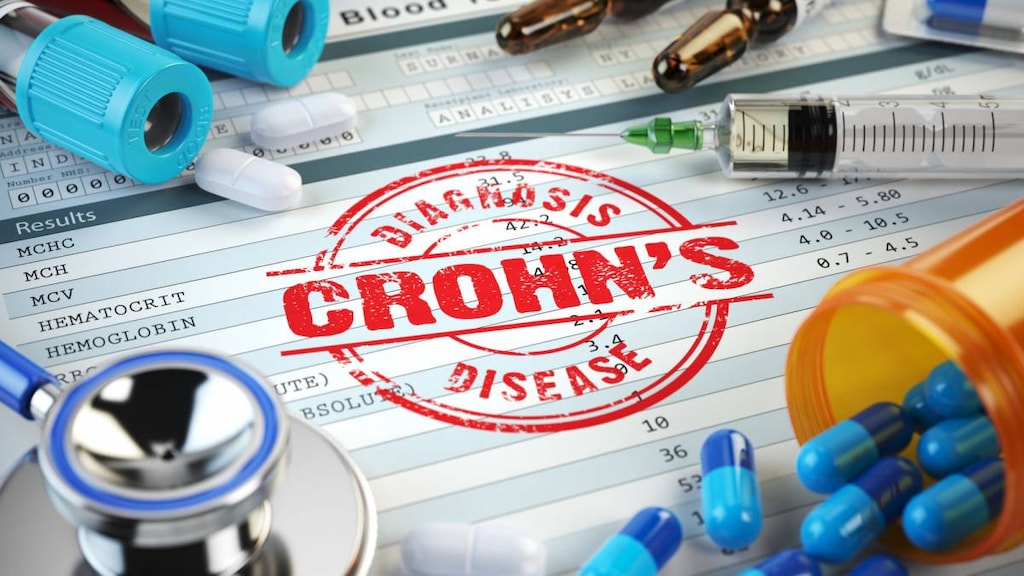Testing for Crohn’s Disease: Diagnosis and Monitoring

Crohn’s disease can be a tricky condition for doctors to diagnose. Its digestive symptoms such as abdominal pain, diarrhea, nausea and vomiting can mimic those of many other medical conditions. And even if the symptoms are chronic, long-lasting or appear periodically in “flare-ups,” that still doesn’t necessarily mean that Crohn’s disease is the cause of the symptoms.
However, doctors have a number of diagnostic tests to determine if you’re one of the 3 million Americans with Crohn’s disease and to rule out other potential causes. In addition, periodic testing is often relied upon to monitor how Crohn’s is impacting your body or to determine the effectiveness of a particular Crohn’s disease treatment.
What you need to know about Crohn’s disease
To understand how Crohn’s disease is diagnosed, it’s helpful to know some of the background about the disease itself. Crohn’s disease is one of several medical conditions that are known as inflammatory bowel diseases. It got its name from Dr. Burrill B. Crohn, who discovered the disease with some of his colleagues in 1932.
Crohn’s disease occurs as a result of the body’s immune system attacking the digestive tract. Unlike ulcerative colitis, another common inflammatory bowel disease, Crohn’s disease can strike anywhere along the digestive tract, from the mouth to the anus, though its most likely victim is the end of the small intestine and the colon.
Symptoms of Crohn’s disease include abdominal pain, persistent diarrhea, rectal bleeding and fatigue. These tend to arise in Crohn’s disease “flare-ups” that last for weeks or months, followed by a period of remission. Over time, these flares can lead to serious health implications, including malnutrition, weight loss and damage to the digestive tract.
Tests for diagnosing Crohn’s disease
If you exhibit the signs and symptoms of Crohn’s disease, there are a variety of tests that your doctor can use to determine if Crohn’s is truly the cause of your digestive troubles and rule out other potential causes. It often takes a combination of the tests described below to arrive at a Crohn's diagnosis.
During the testing process, it’s important to be patient and give your doctor time to rule out other possibilities. Crohn’s disease can be similar to many other conditions, including bacterial infection. And the approach to treating Crohn’s disease can differ quite a bit from similar conditions, so an accurate diagnosis is critical.
- Crohn’s disease blood tests
Blood tests cannot currently directly identify Crohn’s disease on their own, but they can detect some common signs of Crohn’s disease and rule out other causes. For example, a blood test can detect anemia, which is a common sign of Crohn’s disease due to iron not being absorbed in the bloodstream.
Blood testing can also determine if an infection is present in the body, which may be a sign that Crohn’s disease is leading to your symptoms. For example, research has shown that bacterial infection with Mycobacterium avium subspecies paratuberculosis (MAP) is more common with Crohn’s disease, so a Crohn’s MAP test may be helpful in diagnosing the condition.
There are specific blood tests (such as the Prometheus test) that look at antibodies produced in the blood in response to Crohn’s disease and other inflammatory bowel diseases. Though these tests can aid in diagnosis, they are not accurate enough to definitely prove the presence of Crohn’s disease.
- Crohn’s disease stool test
Rectal bleeding is a fairly common sign of Crohn’s disease, although it’s not always easy to detect. Your doctor may need a stool sample to look for signs of blood in the stool. If present, this could be a sign of Crohn’s disease.
- X-ray
An X-ray is a good first step for getting an image of your digestive tract and determining if Crohn’s disease may be the cause of your symptoms. The digestive tract does not show up well on a standard X-ray, so you may need to ingest a contrast chemical a short period of time before the X-ray in order for your digestive system to show up more clearly or you may need to have the substance inserted into your rectum as an enema.
- Other imaging tests
Both computerized tomography (CT scans) and magnetic resonance imaging (MRI) are used from time to time to get a better picture of what is going on inside the digestive tract of someone who may have Crohn’s disease. The type of CT scan that is used to get images of the small intestine is known as CT enterography, and it has replaced the X-rays mentioned above at many hospitals and medical centers. MR enterography is a similar test that uses an MRI machine to analyze the digestive tract issues.
- Endoscopy
An endoscope is a camera and light that are mounted to the end of a thin, flexible tube. Endoscopy involves inserting this tube into the body to get a clearer picture of what’s going on with the digestive tract.
There are several types of endoscopy that might be used to help in diagnosing Crohn’s disease. The most common is a colonoscopy, which involves inserting the endoscope through the anus to analyze the tissues and lining of the lower intestine. An upper endoscopy, which involves inserting the endoscope through the mouth and down the esophagus, may also be warranted in some situations.
One variation on a standard endoscopy is the chromoendoscopy, which involves spraying the interior of the colon with a liquid dye. This highlights potentially problematic areas to make them easier to detect during the endoscopy. There is also a balloon endoscopy that uses an inflatable balloon on the endoscope to open up hard-to-reach areas of the intestines. And then there’s capsule endoscopy, in which the camera is in a capsule that is swallowed. It takes pictures as it travels through the digestive tract and exits the body harmlessly in your stool.
Tests for monitoring Crohn’s disease
Once an individual has been diagnosed with Crohn’s disease, additional tests may be needed from time to time to check on the progression of the disease. These tests can be used to monitor complications of Crohn’s disease, such as abscesses, fistulas or other damage to the digestive tract. Conversely, they can also help determine how well medications and other treatments are managing the condition.
- Blood tests
Just as blood tests can help in diagnosing Crohn’s disease, they can also monitor the progression of the disease. For example, a C-reactive protein (CRP) test looks for markers of inflammation. Lower levels of inflammation may indicate that Crohn’s is being managed properly. Other blood tests, such as liver function tests, electrolyte panels and vitamin B12 testing can help determine the progression of the disease or the nutritional impact of the condition on the individual with Crohn’s disease.
- Imaging tests
The same imaging tests that are used for diagnosing Crohn’s disease — contrast X-rays, CT scans and MRIs — can also be valuable in looking for complications related to Crohn’s disease, such as abscesses, fistulas or other degradation of the lining of the intestines.
- White blood cell scan
One unique imaging test that can be used for monitoring Crohn’s disease is known as leukocyte scintigraphy, or a white blood cell scan. This test shows where white blood cells travel in the body, which is a sure sign of inflammation. It can be helpful for detecting problematic areas within the body related to Crohn’s disease.
- Endoscopy
Just as they are for a Crohn’s disease diagnosis, the various forms of endoscopy are useful for giving doctors a clearer picture of what’s happening within the digestive tract. If complications of Crohn’s disease are suspected, an endoscopy can provide final proof of the nature and severity of that complication.
Article references
- Crohn’s Disease, Mayo Clinic, 2019. https://www.mayoclinic.org/diseases-conditions/crohns-disease/diagnosis-treatment/drc-20353309
- Overview of Crohn’s Disease, Crohn’s & Colitis Foundation, 2019. https://www.crohnscolitisfoundation.org/what-is-crohns-disease/overview
- Signs and Symptoms of Crohn’s Disease, Crohn’s & Colitis Foundation, 2019. https://www.crohnscolitisfoundation.org/what-is-crohns-disease/symptoms
- Crohn’s Disease Diagnosis and Testing, Crohn’s & Colitis Foundation, 2019. https://www.crohnscolitisfoundation.org/what-is-crohns-disease/diagnosis-testing
- Joint MAP Testing Project, Human Para Foundation, 2019. https://humanpara.org/joint-map-testing-project/
- Clinical Focus — Challenges in the Diagnosis of Ulcerative Colitis and Crohn’s Disease, Medscape, 2006. https://www.medscape.org/viewarticle/540595
- Diagnosing Crohn’s Disease and Ulcerative Colitis, Crohn’s & Colitis Foundation, 2010. https://www.crohnscolitisfoundation.org/sites/default/files/legacy/assets/pdfs/diagnosingibd.pdf




